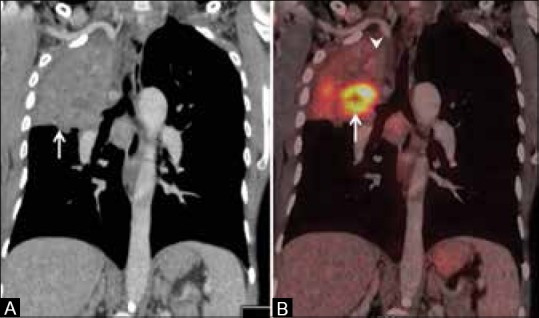Pancoast tumor imaging findings
Jump to navigation
Jump to search
|
Pancoast tumor Microchapters |
|
Diagnosis |
|---|
|
Treatment |
|
Case Studies |
|
Pancoast tumor imaging findings On the Web |
|
American Roentgen Ray Society Images of Pancoast tumor imaging findings |
|
Risk calculators and risk factors for Pancoast tumor imaging findings |
Editor-In-Chief: C. Michael Gibson, M.S., M.D. [1]; Associate Editor(s)-in-Chief: Mazia Fatima, MBBS [2]
Overveiw
A bone scan may demonstrate bone metastases. FDG(18 F fluoro deoxyglucose) PET scans along with contrast enhanced CT may be helpful in the diagnosis of extent of Pancoast tumor.
Other Imaging Findings
Bone Scintigraphy
A bone scan may demonstrate bone metastases.
PET scan
- FDG (18 F fluoro deoxyglucose) PET scans along with contrast enhanced CT may be helpful in the diagnosis of extent of Pancoast tumor. Findings on FDGPET/CT suggestive of Pancoast tumor include:[1]
- Benefits of FDGPET/CT include:[2]
- Accurate delineation of the viable tumor from surrounding atelectasis and collapse or consolidation.
- It may further lead to a change in staging and treatment options of the lung cancer.
- Provide guidance for the biopsy.[3]
 |
References
- ↑ 1.0 1.1 Purandare, NilenduC; Rangarajan, Venkatesh (2015). "Imaging of lung cancer: Implications on staging and management". Indian Journal of Radiology and Imaging. 25 (2): 109. doi:10.4103/0971-3026.155831. ISSN 0971-3026.
- ↑ van Baardwijk, Angela; Baumert, Brigitta G.; Bosmans, Geert; van Kroonenburgh, Marinus; Stroobants, Sigrid; Gregoire, Vincent; Lambin, Philippe; De Ruysscher, Dirk (2006). "The current status of FDG–PET in tumour volume definition in radiotherapy treatment planning". Cancer Treatment Reviews. 32 (4): 245–260. doi:10.1016/j.ctrv.2006.02.002. ISSN 0305-7372.
- ↑ Purandare, Nilendu C.; Kulkarni, Aniruddha V.; Kulkarni, Suyash S.; Roy, Diptiman; Agrawal, Archi; Shah, Sneha; Rangarajan, Venkatesh (2013). "18F-FDG PET/CT-directed biopsy". Nuclear Medicine Communications. 34 (3): 203–210. doi:10.1097/MNM.0b013e32835c5a57. ISSN 0143-3636.